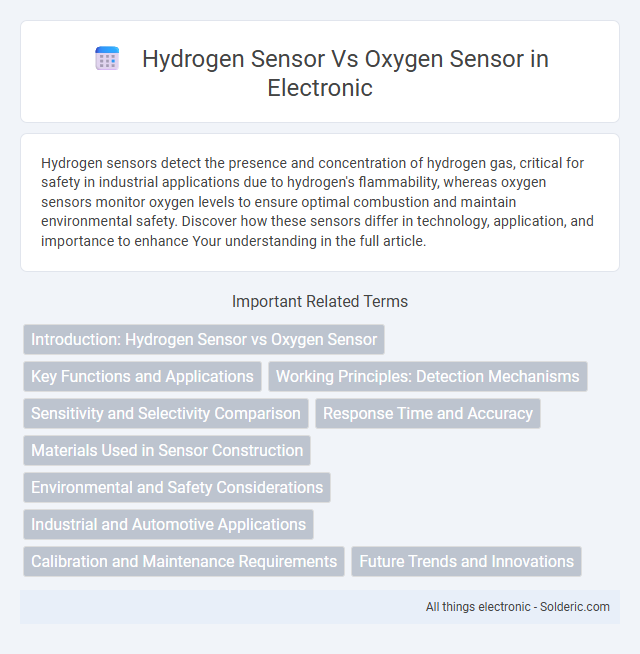Hydrogen sensors detect the presence and concentration of hydrogen gas, critical for safety in industrial applications due to hydrogen's flammability, whereas oxygen sensors monitor oxygen levels to ensure optimal combustion and maintain environmental safety. Discover how these sensors differ in technology, application, and importance to enhance Your understanding in the full article.
Comparison Table
| Feature | Hydrogen Sensor | Oxygen Sensor |
|---|---|---|
| Purpose | Detects hydrogen gas concentration | Measures oxygen level in gases or air |
| Detection Type | Gas-specific sensor for H2 | Electrochemical or zirconia-based sensor for O2 |
| Applications | Fuel cells, leak detection, industrial safety | Automotive emissions, medical devices, environmental monitoring |
| Operating Principle | Chemical or semiconductor sensing of hydrogen molecules | Electrochemical cell or solid electrolyte to measure oxygen concentration |
| Response Time | Fast, typically under seconds | Variable, usually seconds to minutes |
| Sensitivity | High sensitivity to low ppm H2 levels | High accuracy over a wide oxygen concentration range |
| Operating Temperature | Typically room temperature to 200degC | Depends on sensor type; zirconia sensors operate at 400-800degC |
| Cross-Sensitivity | May be affected by other combustible gases | Less affected by other gases, but some interference possible |
| Cost | Moderate to high, depending on technology | Moderate, widely available technologies |
Introduction: Hydrogen Sensor vs Oxygen Sensor
Hydrogen sensors detect the presence and concentration of hydrogen gas, essential for safety in industrial environments and hydrogen fuel applications. Oxygen sensors measure oxygen levels in various settings, critical for combustion control, medical devices, and environmental monitoring. These sensors differ in working principles, target gases, and applications, with hydrogen sensors often based on electrochemical or semiconductor technologies, while oxygen sensors frequently utilize zirconia or electrochemical cells.
Key Functions and Applications
Hydrogen sensors detect and measure hydrogen gas concentrations critical for preventing explosions in fuel cells, hydrogen storage, and industrial processes. Oxygen sensors monitor oxygen levels to ensure combustion efficiency in engines, medical devices, and environmental monitoring systems. Your choice between these sensors depends on whether detecting flammable hydrogen gas or regulating oxygen levels is essential for your safety and performance requirements.
Working Principles: Detection Mechanisms
Hydrogen sensors operate by detecting changes in electrical conductivity or catalytic reactions when hydrogen molecules interact with sensor materials, often utilizing metal oxides or palladium-based components. Oxygen sensors typically rely on electrochemical cells that generate a voltage proportional to oxygen concentration through redox reactions at electrodes, commonly using zirconia or titania ceramics. These distinct detection mechanisms enable precise monitoring of hydrogen or oxygen levels in various industrial and environmental applications.
Sensitivity and Selectivity Comparison
Hydrogen sensors exhibit higher sensitivity due to hydrogen's small molecular size and rapid diffusion, enabling swift and accurate detection even at low concentrations. Oxygen sensors, while highly selective to oxygen, often rely on electrochemical or zirconia-based technologies that provide stable readings but may respond slower compared to hydrogen sensors. Your choice depends on whether you prioritize faster hydrogen detection with high sensitivity or precise oxygen measurement with strong selectivity.
Response Time and Accuracy
Hydrogen sensors typically exhibit faster response times, often within milliseconds, due to the high reactivity of hydrogen gas with sensor materials like palladium or platinum. Oxygen sensors, especially zirconia-based ones, provide superior accuracy in measuring oxygen concentration but may have slower response times ranging from seconds to minutes depending on sensor design. Both sensor types are critical for safety and process control, with hydrogen sensors optimized for rapid leak detection and oxygen sensors favored for precise air-fuel ratio monitoring.
Materials Used in Sensor Construction
Hydrogen sensors commonly employ materials like palladium, platinum, and tin oxide due to their high sensitivity and selectivity to hydrogen gas, enabling rapid and accurate detection. Oxygen sensors often use zirconia or titania ceramics, which exhibit excellent ionic conductivity and stability at elevated temperatures, making them ideal for measuring oxygen concentration in combustion environments. The choice of materials directly influences sensor durability, response time, and operating temperature range, with hydrogen sensors favoring metal-based catalysts and oxygen sensors relying on ceramic electrolytes.
Environmental and Safety Considerations
Hydrogen sensors and oxygen sensors play crucial roles in environmental monitoring and safety management by detecting specific gases to prevent hazardous conditions. Hydrogen sensors are vital for identifying leakages that pose explosion risks in industrial or residential settings, ensuring timely intervention to protect your health. Oxygen sensors monitor atmospheric oxygen levels to prevent suffocation hazards and maintain safe air quality, particularly in confined spaces or medical environments.
Industrial and Automotive Applications
Hydrogen sensors and oxygen sensors play critical roles in industrial and automotive applications by monitoring gas concentrations to ensure safety and optimize performance. Hydrogen sensors detect combustible hydrogen levels in fuel cells and refinery processes, preventing explosion hazards by providing early leak detection. Oxygen sensors regulate air-fuel mixtures in combustion engines and monitor oxidation levels in industrial furnaces, contributing to efficient fuel consumption and reduced emissions.
Calibration and Maintenance Requirements
Hydrogen sensors generally require more frequent calibration due to their sensitivity to environmental factors such as humidity and temperature fluctuations, which can affect measurement accuracy. Oxygen sensors often have longer calibration intervals but require diligent maintenance to prevent sensor contamination and drift over time. Proper calibration and routine maintenance are essential for both sensor types to ensure reliable and precise gas detection in industrial and safety applications.
Future Trends and Innovations
Hydrogen sensors are evolving with advancements in nanomaterials and microelectromechanical systems (MEMS), enhancing sensitivity and response times for applications in fuel cells and safety monitoring. Oxygen sensors are integrating smart technologies and wireless connectivity, enabling real-time environmental monitoring and improved air quality management. Your choice between these sensors depends on emerging innovations that prioritize accuracy, durability, and compatibility with the Internet of Things (IoT) for future-ready solutions.
Hydrogen sensor vs oxygen sensor Infographic

 solderic.com
solderic.com